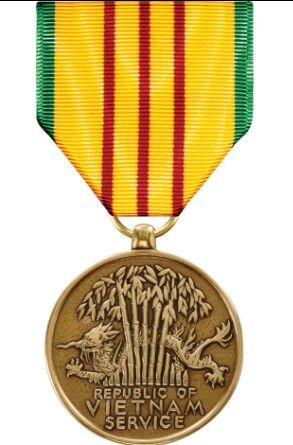50 years since last combat troops left Vietnam
Published 12:30 pm Wednesday, March 29, 2023

- Vietnam Service Medal, awarded to U.S. troops who served in the area of the Vietnam War.
A half-century ago Wednesday, the last American combat troops left Vietnam, a war that had stretched over two decades.
On March 29, 1973, the final platoons of more than three million Americans who had served in the conflict left for American bases in South Vietnam, for ships offshore or bases in the Philippines.
Trending
Since the U.S. inherited the leading Western role in the war from its former French allies in 1954, more than 58,200 Americans had died in Vietnam.
Oregon sent about 57,000 off to fight in Vietnam, with more than 710 killed.
“Hanoi Hilton” to home
As part of the Paris Peace Accords concluded in January 1973, the U.S. agreed to remove combat troops from South Vietnam and North Vietnam agreed to the release of 591 confirmed American prisoners of war held by communist forces in Southeast Asia.
The group included 325 Air Force and 138 Navy personnel, most of which were shot down over enemy targets and were held at the infamous “Hanoi Hilton” prison in the North Vietnamese capital
Others were released by Viet Cong guerillas operating in South Vietnam, as well as communist groups in neighboring Laos, Cambodia and China. The returnees included 77 Army soldiers, 26 Marines and 25 civilians.
Trending
Air Force Capt. Ed Mechenbier, a native of West Virginia, had taken off on June 14, 1967 from the massive American airbase at Da Nang. It was Mechenbier’s 80th combat mission of the war – and his last. His F-4 Phantom was shot down over enemy territory.
Captured by North Vietnamese troops, Mechenbier was taken to Hanoi and held with other POW aviators. That fall, the North Vietnamese brought in a captured Navy aviator. Future Sen. John McCain of Arizona was seriously injured when ejecting from his Navy A-4 Skyhawk was hit by a surface-to-air missile over Hanoi during Operation Rolling Thunder in October 1967.
On Feb. 18, 1973 – Mechenbier and several other POWs were taken to Hanoi’s Gia Lam Airport, where they saw a gleaming four-engine U.S. Air Force C-141 Starlifter military transport on the tarmac. It would be their ride out of Hanoi. After 2,076 days as a prisoner of war, Mechenbier was free.
“When we got airborne and the frailty of being a POW turned into the reality of freedom, we yelled, cried and cheered,” Mechenbier recounted in 2006.
About 80% of the American aviators who were POWs returned to flying roles with the U.S. military. Mechenbier was the last Vietnam War POW in active duty military service, rising to the two-star rank of major general before retiring in 2004.
MIAs – lost and some found
The remains of more than 1,000 Americans originally listed as missing in action during the Vietnam War have been identified and returned to their families for burial over the past 50 years, most often with full military honors.
The Defense POW/MIA Accounting Agency and civilian volunteer groups continue to look for several hundred others who have not been located.
Benny Dexter was a 21-year-old Air Force technical sergeant from Bend driving a jeep north of Saigon when he was captured by Viet Cong forces on May 9, 1966. He was never seen again. His family, including his sister, Dollie Dexter Raymond of Redmond, can’t properly grieve their loss.
“These people can not go to a cemetery and lay a wreath on a grave,” Army Lt. Col. Dick Tobiason of Bend, said during a POW/MIA Recognition Day ceremony in 2019.
May 29 was officially designated National Vietnam War Veterans Day in 2017. It honors those who served, died, were wounded, were missing in action, or gave support to the American effort.
Inheriting a war -and an early Oregon foe
Nazi Germany had captured France in 1940 during World War II. Free French forces under Gen. Charles de Gaulle, fought on the side of American, British, Russian and other allied forces. After the war, France wanted its colonies in “French Indochina” that had fallen under Japanese control. The area included Vietnam, Cambodia and Laos.
Many Vietnamese, some of whom actively fought Japan under the leadership of Ho Chi Minh, sought independence. When the French tried to reassert colonial rule, war broke out that culminated in the withdrawal of France in 1954. Vietnam was divided between the communist North and pro-American south.
For the United States, what started out as an advisory role to the South Vietnamese military morphed over the years into a massive combat role requiring the drafting of new U.S. troops to fight. The first U.S. war death was recorded in 1956. The death toll rose slowly until 1964, when President Lyndon B. Johnson asked Congress to expand the American rule under the Gulf of Tonkin Resolution. U.S. Sen. Wayne Morse, D-Oregon, was one of only two “no” votes among the 100 senators.
“Trying by indirection to obtain congressional approval of our illegal, unilateral military action in South Vietnam without coming forward with a request for a declaration of war,” Morse said during the debate.
Morse lost his 1968 bid for a fourth term in the U.S. Senate, losing by 3,500 votes to State Rep. Robert Packwood, a Republican.
‘Peace with honor’
North Vietnam launched the bloody but failed Tet Offensive in 1968. While American and South Vietnamese troops won the battle, the public in the United States was increasingly questioning the worth of a war that was requiring an unpopular draft to maintain 500,000 troops in Vietnam. The Tet Offensive spiked the body count, with 16,899 Americans killed that year.
President Lyndon Johnson, who had won by a landslide in 1964, announced that he would not seek re-election. Sen. Robert F. Kennedy of New York was building momentum toward winning the Democratic nomination when he was assassinated in Los Angeles after winning the California primary. Democrats turned to Vice-President Hubert Humphrey as their candidate.
Republican Richard Nixon had lost the 1960 election for president to Democrat John F. Kennedy. In a career turnaround, Nixon won the Republican nomination and went on to narrowly defeat Humphrey in a three-way race over Humphrey that also included segregationist former Gov. George Wallace of Alabama, who won 10 million votes.
Nixon said he had plans for how to get the United States out of the conflict – “peace with honor.”
Nixon assured conservatives in Congress, called “war hawks,” that he wouldn’t capitulate to “doves” among lawmakers who wanted troops home immediately. Nixon would eventually expand the combat zone to include neighboring Cambodia and Laos and order the heaviest bombing campaign of the war. But he also ended the unpopular draft.
Enemies agree – but allies squabble
Proposals for peace talks didn’t come to pass during the first two years of Nixon’s term. North Vietnamese leaders opted in March 1972 for a major invasion of the south dubbed the Easter Offensive by U.S. commanders.
The North Vietnamese army troops made advances on the ground, but a massive bombing campaign ordered by Nixon stalled communist gains by late summer.
American and North Vietnamese diplomats began meetings in Paris and on Oct. 11 released a plan approved on both sides calling for a cease-fire. All American troops would pull out of South Vietnam by the end of December. North Vietnam would release prisoners of war at a pace matching the withdrawal.
A “National Council of National Reconciliation and Concord” would be created to organize and oversee free and democratic elections to determine the political future of the South.
But the plan angered senior leaders of the American-backed South Vietnamese government in Saigon, who said allowing troops to stay in position at the time of the cease fire would leave more than 250,000 communist soldiers inside South Vietnam.
When Americans tried to re-negotiate the accord, the North Vietnamese refused and walked away from the Paris talks.
Nixon turned to military tactics to try to force a deal. He ordered the mining of Haiphong Harbor, the main trade port in the North Vietnam. An 11-day heavy bombing campaign of Hanoi and key strategic points in December, known as “the Christmas bombings,” ensued.
The North Vietnamese agreed to resumed peace talks in Paris.
Americans leave – but war goes on
The “Paris Peace Accords” concluded with the “Agreement on Ending the War and Restoring Peace in Vietnam” that was signed on Jan. 27, 1973.
Using heavy air transports and ships, the Americans and allied troops, notably South Korean, turned over their equipment and bases to the South Vietnamese and went home. The last flights carrying American troops left Saigon on March 29, 1973. The last POWs were flown out the same day.
Any thoughts of reconciliation and concord disappeared between the two Vietnams and combat soon resumed, with Hanoi eventually using 30 regular army divisions, alongside masses of Viet Cong guerillas in the south, to topple the Saigon government and capture the capital in April 1975.
The final death toll on all sides has been a question that hangs over the long war to this day.
In 1995, Vietnam released a final estimate of deaths: Up to two million civilians on both sides of the war in Vietnam. The North Vietnamese Army and Viet Cong guerillas lost 1.1 million fighters. Estimates of South Vietnamese soldiers killed range up to 250,000. Of the 58,200 American military personnel who died, an estimated 100 were actually Canadian citizens, according to the National Archives. Often forgotten are the troops of American allies who fought in the war. South Korean reported over 4,000 killed, Australia counts 500 soldiers who died, Thailand reports 350 and New Zealand just under 40.
The estimates do not count French, Vietnamese and other troops and civilians killed in the years before France withdrew in 1954.
If all estimates are accepted, deaths in the war on all sides totaled 3,413,090.





